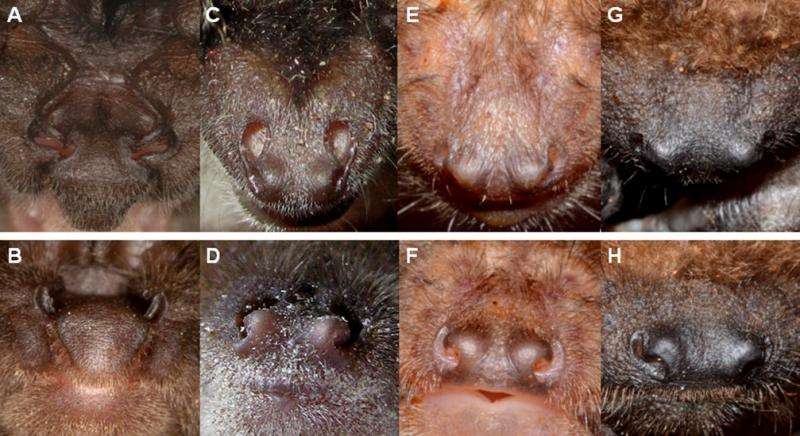Top view is in the upper row and front view is inthe lower row of the noses of Barbastella barbastellus. Credit: (A,B) Christian Dietz; (C)Johanna Hurst; (D) Anna-Maria Seibert; (E-H) Laurent Arthur
The barbastelle bat may emit two different types of weak echolocation signals alternately, one upward through the nose and one downward through the mouth, to find prey while undetected and to sufficiently keep track of the environment, respectively, according to a study published September 9, 2015 in the open-access journal PLOS ONE by Anna-Maria Seibert and colleagues from the University of Tübingen, Germany.
Barbastelle bats prey almost exclusively on eared moths, using "stealth echolocation" signals that are 10-100 times weaker than those of other aerial hawking bats. These low intensity signals prevent early detection of the bat and can be heard by moths only at short distances leaving no time for evasive behavior. While foraging, barbastelle bats alternate between two different echolocation signal types. The authors of this study investigated whether these signals differ in emission direction or source level. They used a 16-microphone array to determine source level and sonar beam direction of more than 300 calls of wild bats in Central France.
The authors found that both types of search signals had very low source levels as compared to other aerial hawking bats. These two signal types were emitted in different directions; type 1 signals were directed downward and type 2 signals upward. The mouth and nostrils in barbastelle bats are roughly perpendicular to each other, and the authors posit that type 1 signals are emitted through the mouth while type 2 signals are emitted through the nose.
The authors suspect that the "stealth" upward signals may be used for the search and localization of prey while remaining undetected; however, the low source level may come at the cost of reducing the detection range for the environment below the bat. Therefore, the more downward directed signals may have evolved to compensate for this disadvantage and may be mainly used for spatial orientation in relation to the environment below the bat. The authors suggest that this signaling system has been adapted to the selective foraging of eared moths.
More information: Seibert A-M, Koblitz JC, Denzinger A, Schnitzler H-U (2015) Bidirectional Echolocation in the Bat Barbastella barbastellus: Different Signals of Low Source Level Are Emitted Upward through the Nose and Downward through the Mouth. PLoS ONE 10(9): e0135590. DOI: 10.1371/journal.pone.0135590
Journal information: PLoS ONE
Provided by Public Library of Science























